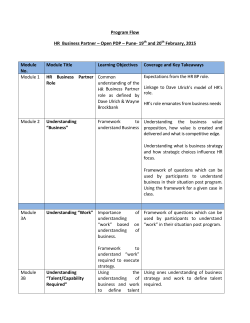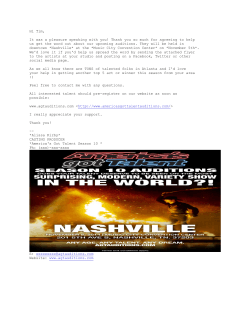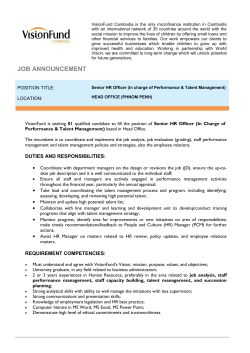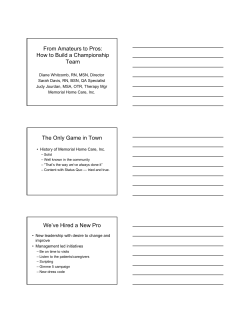
Curb ‘Talent Slippage’ How To Run An At Your Company
August 2007 Volume 7 Issue 8 Curb ‘Talent Slippage’ At Your Company How To Run An Effective Business Meeting! Develop Your Best Employees H ow productive are your business meetings? Would you describe hat do your best employees want the culture that governs your from their jobs? Most often, meetings to more resemble World War they want to keep on growing. III or crazy chaos? During a meeting, When your focus fades on developing do you focus on the agenda at hand or your best employees, their enthusiasm do you concentrate more on breaking a and commitment fade, too. Your best foam cup into bits? Would you qualify How Effective Are Your employees are top performers who Meetings? eating all of the donuts in a meeting as value and seek growth, challenge, and a major accomplishment in your advancement. They seek these rewards anywhere agenda? If these meeting scenarios sound familiar – either inside your company or someone else’s. to you, you are not alone! Many studies have Talent slippage happens when your best and shown that more time is wasted in meetings than brightest walk out the door! in any other business activity. It is estimated that people spend 20-40% (upper management is much Reducing talent slippage in your employee ranks more) of their time in meetings and that meetings is rising in importance because replacing talented are only 44-50% efficient (source: Steve Kaye). employees is becoming even more difficult. You By improving the efficiency of your next meeting, already know that serious employee shortages are you may increase your bottom line. on the horizon as a result of massive workplace retirements (Baby Boomers) and insufficient The first step in improving the efficiency of your numbers of qualified replacements (Generations X business meetings is to recognize that meetings and Y). are a collaborative effort. The very definition of Continued on page three – Talent Slippage a meeting is a TEAM activity where SELECT people gather to perform WORK that requires GROUP effort. All participants of a meeting, Inside This Issue therefore, must play a role in remaining focused and progressing through the meeting in a timely 1. Curb ‘Talent Slippage’ at Your Company manner. 1. How To Run An Effective Business Before calling a meeting, it must first be decided Meeting! whether it is necessary. Remember a meeting is not always the most effective way. Other options 3. One Minute Ideas available might be sending a memo or an email. It 4. I would like to say I never procrastinate, is the responsibility of the meeting solicitor to but that’s not true. Is there a cure? determine the need for calling the meeting and All articles, quotes, and material in this newsletter are copyrighted. © 2007 No part can be who should attend. W reproduced in any form without specific written consent from copyright holder(s). All rights reserved worldwide. www.HiringbyDesign.com Continued on page two – Effective Meeting or engaging in distracting behavior during a meeting are all non-productive behaviors. We agree not to engage in them. Continued from page one – Effective Meeting In general, it is best to invite as few participants as possible (key players only). The solicitor must also review the organization’s calendar, reserve the meeting room and assign a meeting facilitator to be in charge of the agenda. Effective meetings necessitate leadership. Leading a meeting requires attention, confidence, creativity, diplomacy, empathy, flexibility, wits, toughness and yes, humor! The primary role of the leader is to establish the ground rules for the meeting which are namely: to minimize confusion and disruptions and to institute a code of conduct. Some examples of team game rules that are designed to make meetings more effective are: 10. It is okay to disagree during a meeting, but once the group has made a decision, it needs to be supported by everyone outside of the meeting. Passive resistance, sabotage, negative gossip and guerrilla warfare are not okay. 11. Remember to celebrate successes and to thank members for their efforts. In addition to implementing these concepts, an effective meeting leader must enforce a code of conduct in order to maintain a safe environment for discussing ideas. The meeting facilitator should compel the meeting attendees to follow some simple guidelines to ensure an orderly meeting: 1. If you are planning to introduce a proposal or discuss an issue in a group meeting, send out any relevant information to all team members several days before the meeting. • Work as a team • No rank in the room • One speaker at a time • Be an attentive listener 2. Review the agenda and bring any relevant materials with you to the meeting so that we can make informed decisions. • Focus on the issue • Respect others • Suspend judgment • Allow curiosity • Maintain confidentiality 3. Don’t lobby a few members before the meeting and try to ram an idea down the throats of the rest of the group in a “surprise attack.” Keep issues aboveboard and inclusive. “Fight fair.” 4. Come to meetings on time. 5. If you are going to be absent, inform others beforehand and send a stand-in who can make at least some decisions in your name. 6. Focus on listening and seeking understanding before disagreeing. 7. If you are the recorder, distribute complete and accurate minutes to everyone within 48 hours after the meeting. It is as equally important to end a meeting efficiently as it is to conduct it. Besides just ending a business meeting on time there should be a review of agenda items and results, as well as assignments. A set agenda for the next meeting should also be prepared. 8. If you agree to something, do what you say you will do. Be accountable to each other. Having an effective business meeting is a key ingredient to having a successful business. If you would like more information on this subject, please feel free to contact us. 9. Sarcasm, personal attacks, interrupting, dominating the discussion, By Jennifer C. Selland CPBA, CPVA, CAIA, TriMetrix. Well-Run Concepts Continued on next column – www.HiringbyDesign.com Continued from page one – Talent Slippage However, this does not begin to address the larger challenge of replacing your best employees with new top talent who can carry on where they left off! Is your company at high risk for talent slippage? Take a moment to evaluate what your company is doing to develop and engage the interests of your most valuable employees. Here are four questions you can ask that will readily reveal where you need to focus: 1. Who are your best, and therefore your top performing, employees? • Do you have a list for each department? • If so, is that list kept current and regularly reviewed at the executive level? 2. What tools do you have in place to measure employee performance? • Can you name what talents your jobs require for successful performance? • How do you match employees to jobs to assure performance and satisfaction? 3. How are you developing your top performers? • Where specifically do they need to develop in order to be more effective, productive and challenged? • What plans are in place for their development, and do they have input to those plans? 4. How effectively are the above 3 answers working for you now in retaining your top performers, and what improvements need to be made - by when? Experts in talent management conclude that finding and keeping top performing employees will rank as a major concern of business leaders throughout the next decade. Make a plan to curb talent slippage at your company. Focus on providing your best and brightest with the development they seek to become even better! Author: Gayla Doucet, People Powered Solutions LLC, Copyright protected. All rights reserved worldwide. Occupational Outlook Handbook 2006-07 The Occupational Outlook Handbook is a nationally recognized source of career information, designed to provide valuable assistance to individuals making decisions about their future work lives. For hundreds of different types of jobs – such as teacher, lawyer, and nurse – the Occupational Outlook Handbook tells you: • • • • • the training and education needed earnings expected job prospects what workers do on the job working conditions In addition, the Handbook gives you job search tips, links to information about the job market in each State, and more. Check it out at: www.bls.gov/oco/home.htm Epo(u!njtt!ofyu!npoui(t!jttvf/! Tvctdsjcf!opx"! ! ! Learning is about more than simply acquiring new knowledge and insights; it is also crucial to unlearn old knowledge that has outlived its relevance. Thus, forgetting is probably at least as important as learning. ─ Gary Ryan Blair Effective leadership is putting first things first. Effective management is discipline, carrying it out. ─ Stephen Covey www.HiringbyDesign.com 12705 Via Terceto San Diego, CA 92130 Tel: 858-755-7701 E-mail: info@hiringbydesign.com Visit Our Web Site at: www.hiringbydesign.com! I would like to say I never procrastinate, but that’s not true. Is there a cure? S ometimes people think procrastination is a time management problem; truth is you cannot manage time. You have 24 hours each day. To make the most of your days, and eliminate the stress of procrastination, think about managing your choices. Managing choices is a Character Management issue. Character comes from saying what you will do (honesty) and doing what you say (integrity). This is true whether it is something you say to others or a goal or commitment you “say” to yourself. Are you a person who keeps promises? Many people are better about keeping promises to others than to themselves; either way this leads to procrastination. If you are procrastinating you are probably mistaking “might do” and “maybe” for commitment. A commitment problem underlies your procrastination. Each commitment you make with others and each goal or scheduled activity you make with yourself is a promise. As James, the brother of Jesus wrote, “Let your yes be yes and your no be no.” Stop saying to yourself, "later, tomorrow, next week, after tax season, next quarter, (insert your procrastination term here!)." Start saying “I commit to doing the things I say I will do when I say I will do them.” The best time to start is RIGHT NOW! ─ Mark Sturgell, CBC, Performance Development Network – All rights reserved worldwide What We Do – Hiring by Design has a successful track record of bringing growth in business profits and employee performance since 1998. Formerly known as Balance Resources, we specialize in matching the perfect person to the job. Utilizing a 37factor analysis tool to identify and hand-deliver pre-screened, pre-qualified job candidates to employers, we cut out hundreds of hours and thousands of dollars for your company because you don’t have to sort through unqualified applicants. They don’t even hit your deck. As a result of our popular and proven process, employers only see people whose natural behaviors, internal motivators and personal skills are an ideal match for the job. In fact, it is not uncommon for our clients to experience a $100,000 savings in less than 90 days after implementing our recommendations. Along with Talent Screening and Talent Solutions by Design we deliver customized seminars and training that ensures your team’s expertise stays and grows within your company. We also provide expert guidance in career transition for individuals. You can explore our products and further discover why finding top talent just got a whole lot easier with Hiring by Design. 6 Critical Areas Every Executive Needs to Know for Attracting, Developing and Retaining the Best How often has your company missed the mark on hiring people with the right talent for your jobs? If your company is like thousands of others today, it is moving faster than ever and your jobs are growing increasingly complex. At the same time, it’s getting harder and harder to find and hire top talent - yet your business needs the right people in the right jobs more than ever. Download our FREE eye opening Special Report: 6 Critical Areas Every Executive Needs to Know for Attracting, Developing and Retaining the Best and get the inside tips for outpacing your competition in the Knowledge Economy. To And Complete The Form to Download Your FREE Report! We hope you enjoyed our newsletter! Please send any comments to us! Visit Our Web Site at: www.hiringbydesign.com Call 858-755-7701 or E-mail: info@hiringbydesign.com www.HiringbyDesign.com
© Copyright 2025





















